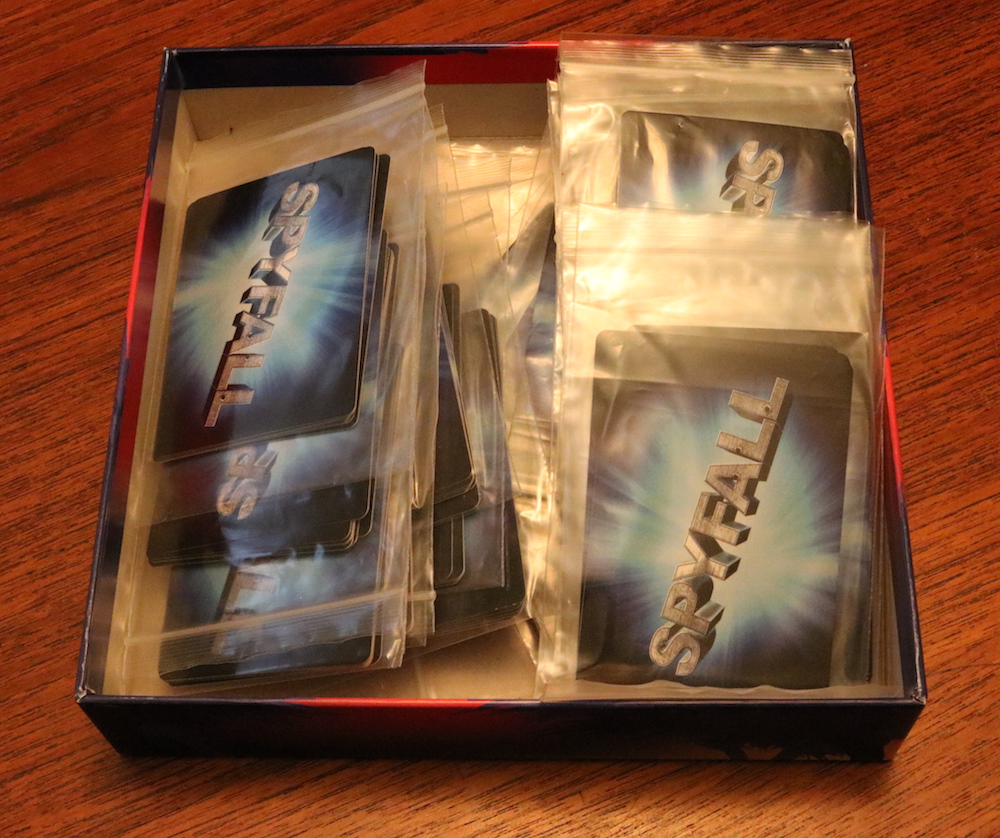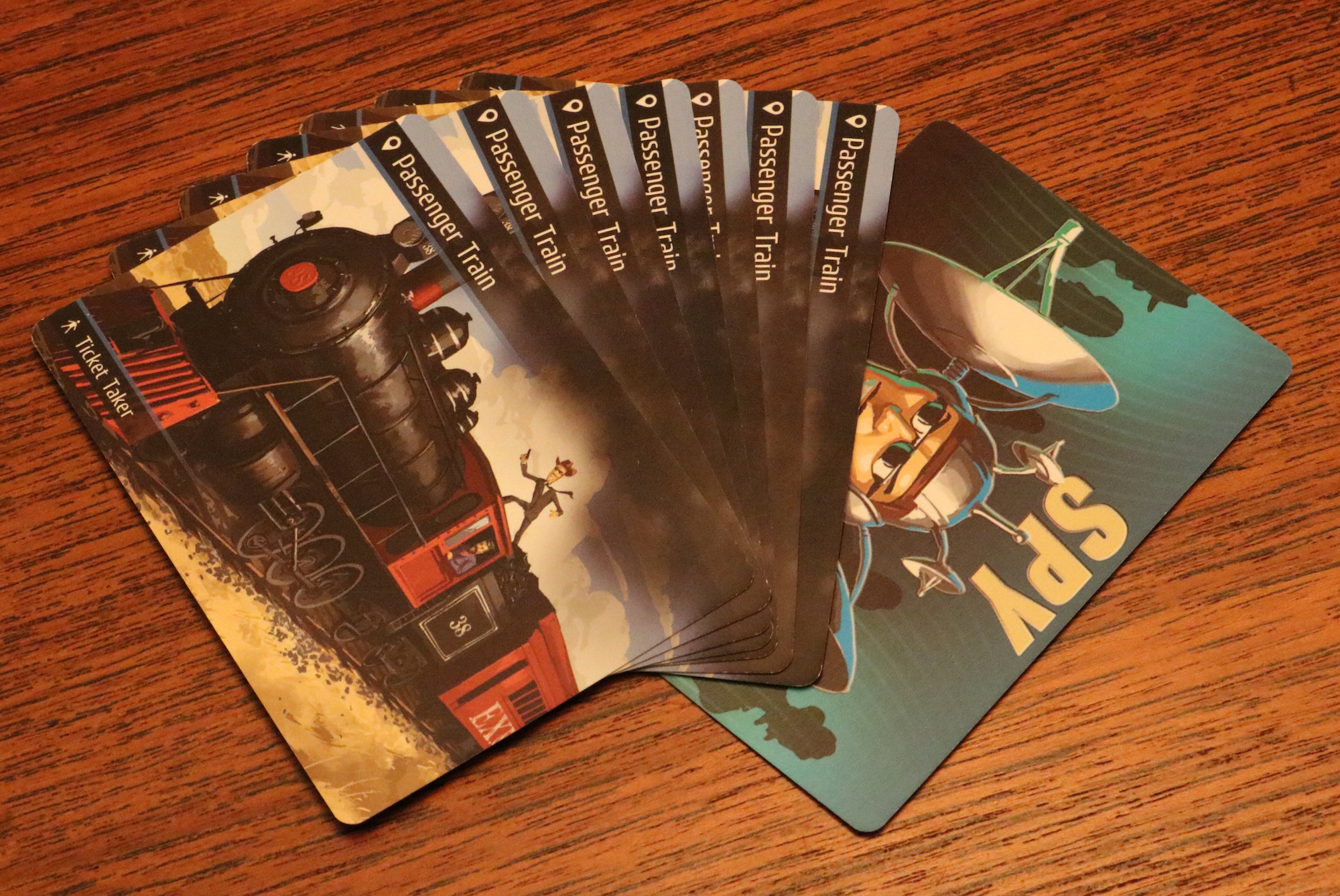Spyfall is a social deduction game for 3-8 players in the format of one-against-all, in which players are assigned secret roles (spy, or not spy with varied roles) by being dealt face down cards, and must discover hidden information from other players.
Game Components
The game consists of sets of cards, one for each location included in the game, and a spy card for each location. On first obtaining the game, you must sort the cards so that all cards of one location are together, with a spy card on top, and then place these piles into little baggies. Setting up the game correctly is critical, because to ensure the spy card is included in each game, it must be on top of the deck, to allow for varied player counts.

One frustrating aspect of this is that the little baggies included are a bit flimsy, such that 2 of them ripped during initial set up, and only one back up bag is included. We have one deck in a ripped baggie, and don't play often enough to remember which location is in that baggie, but a regular player would have to change which location was in the ripped bag blindly, or else would give away the location by the unique bag. Individual bags can't be replaced for the same reason, unless the replacement is identical to the others. The cards themselves are a good quality, and are sturdy enough to stand up to repeated use, particularly considering that the cards are barely handled during gameplay.

Gameplay
First, a location must be chosen - turning the bags face down and shuffling them by spreading them around the table is the most efficient way to do this. The game is played with multiple rounds, so luckily this setup is very quick. The dealer carefully takes the cards out of the bags, keeping them facedown, and draws the appropriate number of cards off the top of the deck (again, all face down). The cards are shuffled and distributed, one each, to the players, so that one person receives a spy card, and everyone else receives a card showing the location of the game, and giving them a role to play.
The game is a race between the spy and the rest of the players, with a maximum duration of 8 minutes, for the spy to identify the location, or for the other players to identify the spy. The only tool is asking other players questions and observing their responses; players take turns asking each other questions pertaining to the location, i.e. When did you get here? What are you wearing? When do you get paid? etc. From the questions that people ask and the answers that are given, the spy tries to deduce the location, and everyone else tries to identify the spy. At any time, a player can accuse another player of being the spy - the timer is paused, and all players vote without discussion by giving a thumbs up or thumbs down. If a majority agree that the accused player is the spy, the accused player flips over their card; if they are the spy, the rest of the players gain points, and if they were a non-spy player, the spy gains points. If the majority gives the thumbs down, the timer and game continue.
The spy can also, at any time they feel they know the location, flip over their card, revealing that they are the spy and making a guess at the location, winning only if they are correct.

If the end of the timer is reached, each player takes turns accusing someone of being the spy with the same voting mechanism (no discussion, thumbs up or thumbs down) - the round ends if a majority agrees yes on any vote, and the group wins if the spy is identified, with the spy winning if another player is voted to be the spy.
We found the points system a bit unnecessary and mostly played it as a fun warmup/party game with just success and failure being the outcome of each round, but the points system does impact the strategy a bit more if you're playing a multi-round game so definitely use it if you're playing with strategically minded players.
Occasionally you will have bad runs where one or two players are the spy repeatedly, but that can lead to your own little meta-game of distrust within a group and there's no good way to mitigate this obviously.
Conclusions
This is a fantastic party game! It accommodates a wide range of group sizes at 3-8 players (although larger groups may be more fun than smaller ones), and is very simple to teach. Non-gamers will not feel overburdened by rules, and there is no bookkeeping; there is no downtime as every question is important for all players to pay attention to, even if they are not directly involved in the exchange. Rounds are so quick, with a maximum time limit of 8 minutes, that it is easy to move on from any mistakes; in any case, in the many rounds that we have played, coming to the end of the timer is rare. There is significant replayability, and as the game clocks in at about $20 or less and comes in a compact box, it is easy to justify owning both in price and in space. For an interlude at a game night, a lunch game with coworkers, or a family gathering, this game is well worth the investment.
